Viewing: Blog Posts Tagged with: douglass, Most Recent at Top [Help]
Results 1 - 25 of 40
Blog: Gurney Journey (Login to Add to MyJacketFlap)
JacketFlap tags: Dinotopia, Journey to Chandara, Preliminary Sketches, Add a tag
Blog: Gurney Journey (Login to Add to MyJacketFlap)
JacketFlap tags: Color, Journey to Chandara, Lighting, Imaginative Realism, Color and Light Book, Add a tag
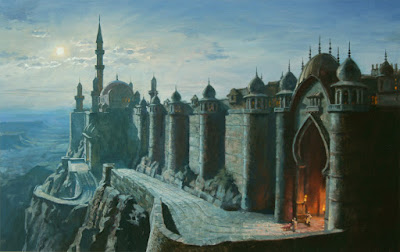 |
| Khasra by Moonlight by James Gurney, 12 x 18 inches, oil on board |
I quickly discovered that I had to move the actual lighting position quite far to the left, much farther to the left than the position of the moon in the painting.
My Public Facebook page
GurneyJourney on Pinterest
JamesGurney Art on Instagram
@GurneyJourney on Twitter
Blog: Gurney Journey (Login to Add to MyJacketFlap)
JacketFlap tags: Dinotopia, Journey to Chandara, Visual Perception, Add a tag
If you walk around the stairs clockwise, you proceed infinitely downstairs, and if you walk counterclockwise, you go upstairs forever without gaining in altitude.
 |
| "Scholar's Stairway," Oil on board, 12 x18 inches. |
To find out, I asked vision scientist Greg Edwards, president of Eyetools, Inc., to run some eye tracking tests using this image as the subject.
-------
Previous posts about my stairway painting:
Credit to Mr. Penrose
Using a Perspective Grid
Blog: Gurney Journey (Login to Add to MyJacketFlap)
JacketFlap tags: Dinotopia, Miniatures, Journey to Chandara, Add a tag
Blog: Gurney Journey (Login to Add to MyJacketFlap)
JacketFlap tags: Dinotopia, Journey to Chandara, Museum Visits, Add a tag
In connection with the exhibition, I'll be doing a public presentation on Thursday, October 29: 1 - 2:30 pm at Levitt Auditorium with a reception following.
Blog: Gurney Journey (Login to Add to MyJacketFlap)
JacketFlap tags: Dinotopia, Journey to Chandara, Add a tag
I've always had a fondness for exuberantly painted cars. Here's one in Ohio that features Will Denison from Dinotopia: Journey to Chandara painted on the hood.
In case you couldn't make it out, here's the painting it's based on.
Previously: Fan Fun, Waterfall City mosaic, and Dinotopia in Lego
Blog: Gurney Journey (Login to Add to MyJacketFlap)
JacketFlap tags: Dinotopia, Journey to Chandara, Elementary Schools, Add a tag
Dr. Jo Ann Leggett, director of the Children’s House preschool of Victoria, Texas recently completed a Dinotopia-themed project for the school’s summer program, and she sent some photos to share.
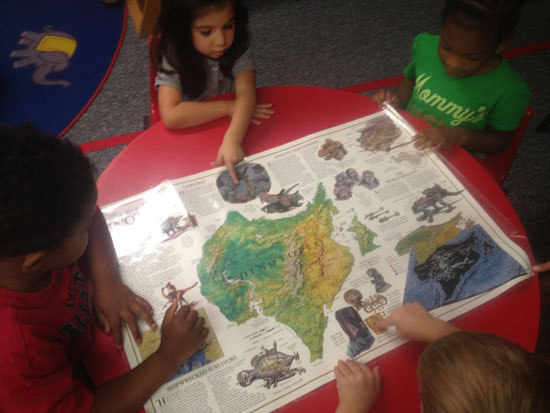
Dr. Jo says: "Children delighted in all the books," and they learned about geography from the Dinotopia map.

They tried "plank walking," a Dinotopia game that I introduced in "Journey to Chandara."
To succeed at plank walking, everyone has to pull the ropes and lift their feet together as a team.

"Dinotopia is our 'most-looked-forward-to' unit at the school. Thank you for your inspiration," says Dr. Jo.
Thank YOU, Dr. Jo! If you're a teacher of any age group and would like to spotlight Dinotopia at your school, please write me a letter. I’ll be happy to send you a list of suggested games, projects, and activities, and I'll include a signed card to help you get the ball rolling.
Previously:
Dinosaurs Invade Millburn High School
Science, Art, and Fantasy (Elementary School)
Blog: Gurney Journey (Login to Add to MyJacketFlap)
JacketFlap tags: Paint Technique, Journey to Chandara, Add a tag
Here is an animated step-by-step sequence of a painting from Dinotopia: Journey to Chandara (2007). The painting shows a retired musical conductor named Cornelius Mazurka and his Therizinosaurus Henriette (left) surrounded by old musical instruments, with Arthur Denison and the Protoceratops Bix on the right.
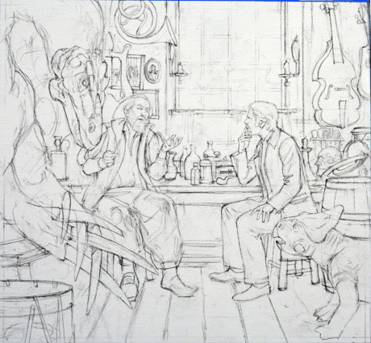
(Direct link to animated gif) This way of painting involves doing a careful pencil drawing on illustration board, sealing it with acrylic matte medium, laying in transparent color, and then proceeding to the finished rendering, area by area, beginning with the center of interest.
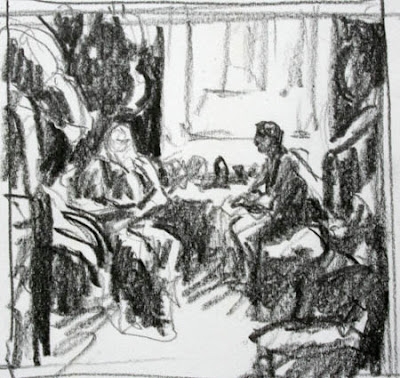
EDIT: to answer Tom's suggestion, I've made the animation a lot slower. And Ben, I have added above the preliminary pencil thumbnail showing how I worked out the basic tonal design before getting models and shooting reference. In this case I didn't do a full charcoal preliminary, just this quick (but very helpful) tonal study.
-------
The original painting "Old Conductor" is currently on exhibit at NHIA in Manchester, New Hampshire through March 13.
Thanks to Stapleton Kearns and Lines and Colors for reviewing that exhibit.
Journey to Chandara signed from my web store and from Amazon
Blog: Gurney Journey (Login to Add to MyJacketFlap)
JacketFlap tags: Dinotopia, Journey to Chandara, Museum Visits Plein Air Painting, Add a tag
(Video link) Here's a video that tells the behind-the-scenes story of the origins of Dinotopia, made for the 20th anniversary edition book reissue and the Lyman Allyn exhibition.
The exhibition called "Dinotopia: Art, Science, and Imagination" ends February 2 at the Lyman Allyn Art Museum in New London, Connecticut. The show has more than 100 objects: original oil paintings, preliminary sketches, maquettes, and dinosaur fossils.
There's more good news. Another Dinotopia exhibition called "Dinotopia: The Fantastical Art of James Gurney" will have a short run from Wednesday, February 20 through Wednesday, March 13, 2013 at the New Hampshire Institute of Art in Manchester. That show will include Dinosaur Parade, Garden of Hope, Dinosaur Boulevard and many other classic images.
-----
The four Dinotopia books mentioned:
Dinotopia: A Land Apart from Time, 1992
Dinotopia: The World Beneath, 1995
Dinotopia: First Flight, 1999
Dinotopia: Journey to Chandara, 2007
Blog: Gurney Journey (Login to Add to MyJacketFlap)
JacketFlap tags: Journey to Chandara, Add a tag
Blog: Gurney Journey (Login to Add to MyJacketFlap)
JacketFlap tags: Dinotopia, Journey to Chandara, Models Posing, Add a tag
Sometimes it's fun to act out a scene, even if the photo reference that you get out of it isn't that useful directly.
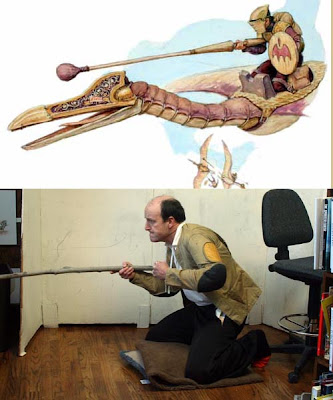
The idea is to get into the spirit of the action, feel the wind in your face and hear the screech of the pterosaur.
I think that's more important than getting a photographically real piece of reference to copy. If you can identify with the weight and balance of things, and especially the emotion, you've got 90% of the problem solved.
The painting of "Air Jousting" is from Dinotopia: Journey to Chandara.
Previous and related posts:
Air Jousting
My Preference for Reference
New Use for Refrigerator Cartons
Blog: Gurney Journey (Login to Add to MyJacketFlap)
JacketFlap tags: Dinotopia, Journey to Chandara, Add a tag
Dinotopia: Journey to Chandara opens with the discovery of the lost Chandara journal of Arthur Denison. 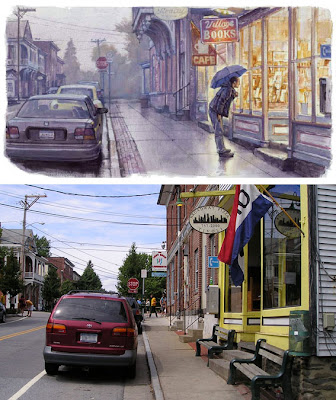
To make the used bookstore look magical and mysterious, I wanted it to be a rainy twilight. I shot location reference in Tivoli, New York.
Then it was just a matter of turning the pizza shop into a bookstore, widening the sidewalk, and generally putting the smell of coffee into it.
--------
You can order Dinotopia: Journey to Chandara from me and I’ll sign it for you.
Or you can pick it up from Amazon.
Or maybe you can find it in a used bookstore on a rainy night...
Blog: Gurney Journey (Login to Add to MyJacketFlap)
JacketFlap tags: Journey to Chandara, Museum VisitsPlein Air Painting, Add a tag
An exhibition of children’s book illustration has opened at the University of New England’s gallery in Portland, Maine, curated by its director, Anne Zill, at left.
The show includes original works by Dr. Seuss, Maurice Sendak, Jules Feiffer, Jerry Pinkney, Eric Carle, Barry Moser, and Trina Schart Hyman.
I’m honored to have two Dinotopia paintings in the show, “Windmill Village” and “Gold Dome.” The exhibition is on view through Oct. 30 .
"Children's Book Illustrators" official show site. http://www.une.edu/artgallery/childrensbook.cfm
Thanks to A.Y. Kamila of the Portland Press Herald blog for the photo.
Blog: Gurney Journey (Login to Add to MyJacketFlap)
JacketFlap tags: Dinotopia, Journey to Chandara, Add a tag
Many Dinotopia characters went through various stages until I was happy with them. The mountain farmer from Dinotopia: Journey to Chandara was one example.
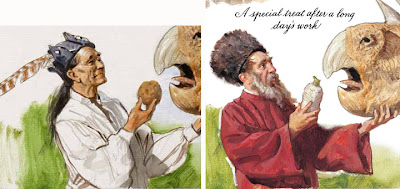
Normally I try to catch problems in the sketch stage, but this time I was nearly finished with the transparent oil rendering when I realized that this character looked too similar to other characters in the book. Also, the potato he was feeding to the dinosaur looked sort of like a rock.
So I took the pose again and repainted him as a bearded man of Russian descent, made his outfit red, and changed the potato to a Burmese turnip. His name Ilya Shinshik evokes my two favorite Russian painters: Ilya Repin and Ivan Shishkin.
When it comes to such corrections, oil is very forgiving. Naturally, I had to restate everything more opaquely and paint white over the parts I needed to cover. But the change only took a day, and the first character was never seen again--until now.
Dinotopia: Journey to Chandara from Amazon
Dinotopia: Journey to Chandara signed from the Dinotopia Store
Blog: Gurney Journey (Login to Add to MyJacketFlap)
JacketFlap tags: Dinotopia, Journey to Chandara, Add a tag
Many Dinotopia characters went through various stages until I was happy with them. The mountain farmer from Dinotopia: Journey to Chandara was one example.

Normally I try to catch problems in the sketch stage, but this time I was nearly finished with the transparent oil rendering when I realized that this character looked too similar to other characters in the book. Also, the potato he was feeding to the dinosaur looked sort of like a rock.
So I took the pose again and repainted him as a bearded man of Russian descent, made his outfit red, and changed the potato to a Burmese turnip. His name Ilya Shinshik evokes my two favorite Russian painters: Ilya Repin and Ivan Shishkin.
When it comes to such corrections, oil is very forgiving. Naturally, I had to restate everything more opaquely and paint white over the parts I needed to cover. But the change only took a day, and the first character was never seen again--until now.
Dinotopia: Journey to Chandara from Amazon
Dinotopia: Journey to Chandara signed from the Dinotopia Store
Blog: Gurney Journey (Login to Add to MyJacketFlap)
JacketFlap tags: Dinotopia, Journey to Chandara, Models Posing, Add a tag
When the Norman Rockwell Museum in Massachusetts hosted a Dinotopia exhibition in 2006, a small group of Dinotopia fans from all over the world assembled at a mini-convention called “The Stockbridge Stomp.” 
I joined them for the festivities and then invited them to my studio a short drive away, so that they could pose for a painting I was working on. 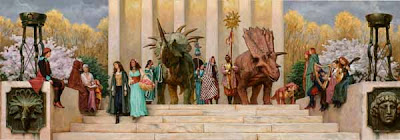
We had a big bowl of homemade soup together, and then they put on costumes, some of which they brought with them. They posed in small groups, imagining themselves standing beside a Styracosaurus and a Chasmosaurus. Many of the figures in the painting were based on that impromptu gathering.
The painting appeared on the title page of Dinotopia Journey to Chandara. The painting also appears in Color and Light, page 116.
This painting will be one of about 40 paintings from Dinotopia Journey to Chandara, opening today at the The Alden B. Dow Museum of Science and Art in, Midland, Michigan.
----------
The Alden B. Dow Museum of Science and Art/ Midland Center for the Arts
Web article about the exhibit, which includes “Bigger than T. Rex: Giant Killer Dinosaurs of Argentina.”
Journey to Chandara at the Dinotopia Store.
Journey to Chandara on Amazon.
Thanks to all the Stompers!
Blog: Gurney Journey (Login to Add to MyJacketFlap)
JacketFlap tags: Dinotopia, Journey to Chandara, Museum Visits, Add a tag
Advanced pterosaur pilots, or “skybax riders” as they are called in Dinotopia, learn the sport of air jousting. 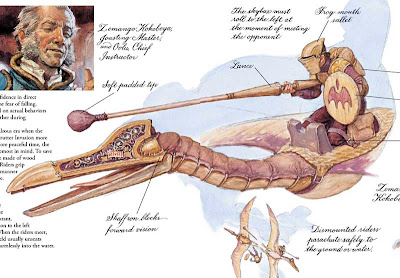
The armor is a lightweight version of horse jousting armor from the Middle Ages in Europe, where the rider can only see through a narrow slit in his sallet, or helmet. The protection for the eyes of the skybax makes him blind during the approach. A dismounted skybax rider must parachute to the ground.

The final oil painting was published in Dinotopia: Journey to Chandara (2007), but it was based on a quick marker sketch that I did much earlier.
Beginning January 20, the original painting will appear along with more than 40 of my other paintings, in the exhibition: Dinotopia: Journey to Chandara, The Paintings of James Gurney, at the The Alden B. Dow Museum of Science and Art in Midland, Michigan. The show is the same as the one recently in Lucca, Italy.
______
The Alden B. Dow Museum of Science and Art/ Midland Center for the Arts
Web article about the exhibit, which includes “Bigger than T. Rex: Giant Killer Dinosaurs of Argentina.”
Journey to Chandara at the Dinotopia Store.
Journey to Chandara on Amazon.
Blog: Gurney Journey (Login to Add to MyJacketFlap)
JacketFlap tags: Paint Technique, Journey to Chandara, Add a tag
The new October/ November issue of International Artist magazine has a four-page feature on the making of the painting “Old Conductor” for Dinotopia: Journey to Chandara.The reproduction of the various steps are shown larger and in more detail than what appears in Imaginative Realism, and I included some of the reference photos.
This issue has other step-by-step demos, including an alla prima oil portrait by Tony Pro. “The Art of the Portrait,” a regular feature of the magazine by Gordon Whetmore, shares news about artists such as Jeremy Lipking, Michael Shane Neal, and Everett Raymond Kinstler.
------
International Artist magazine
Previously on GJ: the Washin Stage
Blog: Gurney Journey (Login to Add to MyJacketFlap)
JacketFlap tags: Dinotopia, Journey to Chandara, Add a tag
The second of three original Dinotopia paintings for sale in the upcoming auction shows the Imperial Palace of the city of Chandara. The view looks east across the Zhengtao River. The emperor’s palace occupies a high and remote prominence in the center of the city. Morning sunlight illuminates the top of the gold dome and the flying buttresses, while thunderclouds assemble over Silver Bay.
The view looks east across the Zhengtao River. The emperor’s palace occupies a high and remote prominence in the center of the city. Morning sunlight illuminates the top of the gold dome and the flying buttresses, while thunderclouds assemble over Silver Bay.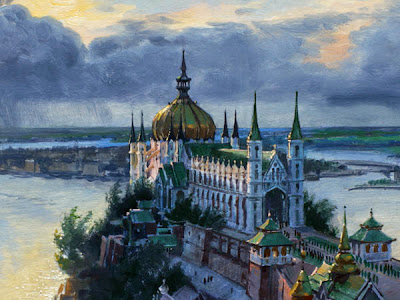 My approach was inspired by several artists of the past who specialized in otherworldly moods in landscape: Frederic Church, Isaac Levitan, Andreas Achenbach, Hans Gude, and Jean Ferdinand Monchablon.
My approach was inspired by several artists of the past who specialized in otherworldly moods in landscape: Frederic Church, Isaac Levitan, Andreas Achenbach, Hans Gude, and Jean Ferdinand Monchablon.
The painting is in oil, and appeared in Dinotopia: Journey to Chandara, which was published in USA, France, Hungary, Romania, Bulgaria, Czech Republic, Greece. It also was published in Imaginative Realism: How to Paint What Doesn’t Exist. Other paintings from the book toured museums in Yverdon, Switzerland, Newcastle, England, and Nantes, France.
-------
Earlier post about another painting in the Tajan auction.
Galerie Daniel Maghen is the expert adviser in the sale. For more information, please email Olivier Souille at "[email protected]"
Tajan’s October bande dessinée auction (the final online catalog is still in preparation).
James Gurney Original Art blog
Dinotopia website
James Gurney Original Art blog
Dinotopia: Journey to Chandara
Blog: Gurney Journey (Login to Add to MyJacketFlap)
JacketFlap tags: Dinotopia, Journey to Chandara, Preliminary Sketches, Add a tag
Here’s the preliminary line drawing for a Dinotopia painting called “Flight Past the Falls.” I did it on a separate piece of paper, photocopied it, and transferred it to the canvas with an Artograph projector to the canvas.  The rider on the pterosaur was drawn on a separate layer of paper and moved around until I got the position I wanted.
The rider on the pterosaur was drawn on a separate layer of paper and moved around until I got the position I wanted.
What I want you to notice is the “draw through,” which means the lines carried across to invisible parts of the form. For example:
1. Circular curve of the bottom half of the globe.
2. Chest of pterosaur hidden by wing.
3. Eye level or horizon hidden behind falls.
4. Curvature of Moorish arch hidden by the flanking buttresses.
Note also the centerline markings on the globe, and the winged sculpture. Also note the perspective grid on the side of the drawing.
Draw-through helps you keep track of what the form is doing when it slips behind something else. If you work out the draw-through on a separate piece of paper from the finished work you don’t have to worry about erasing the lines or covering them up.
You can apply the draw-through principle to figure drawing or any drawing, especially in the early stages. It will make your final drawing or painting more solid and convincing. When an architect draws a building elevation, she knows where the windows and doors are located on the back side of the building.
---------
Earlier GJ post about the skybax model and the finished image.
Blog: Gurney Journey (Login to Add to MyJacketFlap)
JacketFlap tags: Journey to Chandara, Add a tag
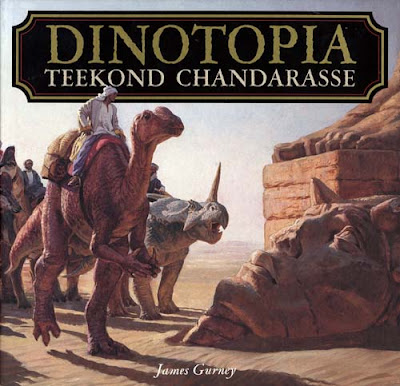 Here's the new Estonian edition of Dinotopia: Journey to Chandara.
Here's the new Estonian edition of Dinotopia: Journey to Chandara.
Estonian publisher's website
Order a signed copy of the English edition (US only) at the Dinotopia Store.
Blog: Gurney Journey (Login to Add to MyJacketFlap)
JacketFlap tags: Lettering, Dinotopia, Journey to Chandara, Add a tag
The painting on the cover of Dinotopia: Journey to Chandara shows a convoy of dinosaurs and people crossing the desert, passing huge statues from one of Dinotopia’s ancient civilization. 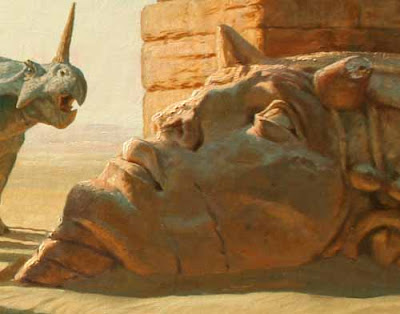 As I painted the fallen stone face on the right side of the picture, I was thinking of Percy B. Shelley’s 1818 sonnet “Ozymandias,” which describes a traveler’s encounter with a colossal ancient statue in the desert: “Near them, on the sand, half sunk, a shattered visage lies.”
As I painted the fallen stone face on the right side of the picture, I was thinking of Percy B. Shelley’s 1818 sonnet “Ozymandias,” which describes a traveler’s encounter with a colossal ancient statue in the desert: “Near them, on the sand, half sunk, a shattered visage lies.”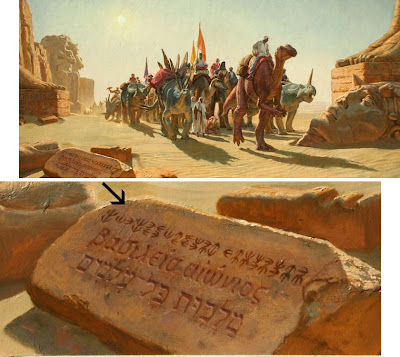 The inscription on the stone at the lower left echoes Shelley’s theme of the mute arrogance of a vanished civilization. The phrase says “EVERLASTING DOMINION” in Dinotopian footprint alphabet, ancient Greek, and Aramaic (written with Hebrew letters).
The inscription on the stone at the lower left echoes Shelley’s theme of the mute arrogance of a vanished civilization. The phrase says “EVERLASTING DOMINION” in Dinotopian footprint alphabet, ancient Greek, and Aramaic (written with Hebrew letters).
The features on the fallen face in the painting are based not on Egyptian forms, but on casts of Michelangelo's David.
----------
Links:
The painting is on view in "The Fantastical Art of James Gurney" which opens at the Norton Museum tomorrow.
The Dinotopia online store, where you can order a signed copy of Journey to Chandara.
Dinotopia Wiki on the Footprint Alphabet
Wikipedia on the poem Ozymandias
Previous GJ post on using plaster casts, including the David casts.
Blog: Gurney Journey (Login to Add to MyJacketFlap)
JacketFlap tags: Dinotopia, Journey to Chandara, Museum Visits, Add a tag
The staff of the Norton Museum of Art in West Palm Beach, Florida is putting the final touches on the Dinotopia exhibit, which will open this weekend.“Dinotopia: The Fantastical Art of James Gurney” contains over 50 original oil paintings, along with preliminary sketches, plein air studies, scale maquettes, and dinosaur fossils. This will be the first venue to show the sculpt of the Protoceratops Bix made by Jim Henson’s Creature Shop.
I’ll be attending, this weekend, with a colored pencil drawing workshop on Saturday, June 5 from 1:00-4:00 (there’s still space available), and I'll give a lecture on Sunday at 3:00, with a booksigning afterward. Come by and say hi and get a book or poster signed. There will be a whole family day celebration on Sunday June 6 from 1:00 to 5:00 with live animals and activities. And there will be events going on all around town during the whole summer. The exhibition will be up through September 5. Call 561. 832.5196 for more information.
There will be a whole family day celebration on Sunday June 6 from 1:00 to 5:00 with live animals and activities. And there will be events going on all around town during the whole summer. The exhibition will be up through September 5. Call 561. 832.5196 for more information.
Norton.org Dinotopia Exhibit.
Download the full PDF of press release with schedule.
Blog: Gurney Journey (Login to Add to MyJacketFlap)
JacketFlap tags: Dinotopia, Paint Technique, Journey to Chandara, Add a tag
Blog reader and academic painting student Stephen J. asked me the following question:
“I, and some of my classmates, have been dealing with the issue of how much drawing one should do on the surface of a canvas (board, panel, paper etc) before jumping into paint. This is outside of the studies that are done beforehand and assumes that a drawing is not being transferred. Basically we've bumped into the issue of doing relatively tight, refined lay-ins in pencil and then completely losing those delicate drawings once paint is applied. Some of the teachers and students believe in "finding" the drawing with paint rather than doing a tight charcoal/graphite underdrawing. This could be related to the fact that most of our teachers here seem to advocate the thicker paint application of a certain style of Alla Prima, but I'm not sure.”
-
Dear Stephen:
I practice and recommend both extremes, depending on the picture. When I'm painting outdoors on location or doing a portrait from life, I completely find the subject with the brush (no pencil drawing at all), beginning with spots, big divisions, and measurements. 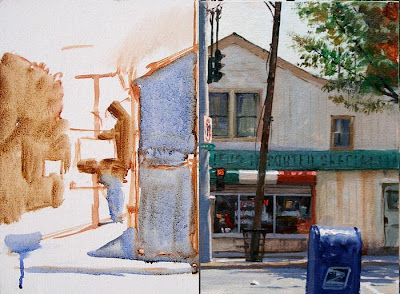 Here’s the loose lay-in demonstrated on a 9x12 inch plein-air study, shown with the finish on the right half and the first statement on the left.
Here’s the loose lay-in demonstrated on a 9x12 inch plein-air study, shown with the finish on the right half and the first statement on the left.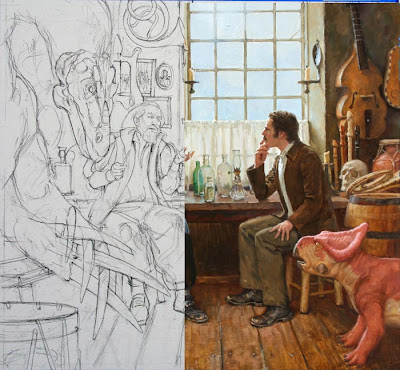 With other pictures, however, it's a different story. In this painting from Dinotopia: Journey to Chandara, I did a careful pencil drawings directly on the final surface, and I sometimes work out the drawing on a separate piece of paper.
With other pictures, however, it's a different story. In this painting from Dinotopia: Journey to Chandara, I did a careful pencil drawings directly on the final surface, and I sometimes work out the drawing on a separate piece of paper.
With a very complex subject, like a sinking Civil War sailing ship, there's no other way I can imagine approaching it.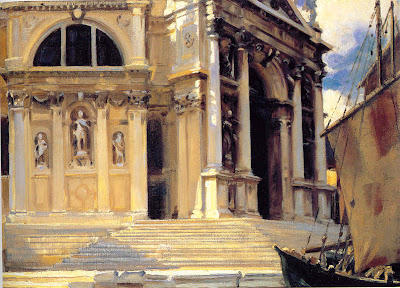 Sargent, the maestro of alla prima, sometimes did very careful pencil drawings before he tried to tackle some of his Venetian studies of architecture. Richard Ormond’s new book on his Venetian work includes a reproduction of a line drawing that he did to work out the perspective of the church of Santa Maria della Salute.
Sargent, the maestro of alla prima, sometimes did very careful pencil drawings before he tried to tackle some of his Venetian studies of architecture. Richard Ormond’s new book on his Venetian work includes a reproduction of a line drawing that he did to work out the perspective of the church of Santa Maria della Salute.
With an imaginary scene with a lot of figures, historical elements, mechanical forms, lettering, or anything of that kind, I recommend following something like Rockwell's method of the separate full size charcoal comprehensive,
Blog: Gurney Journey (Login to Add to MyJacketFlap)
JacketFlap tags: Journey to Chandara, Add a tag
Nature is full of patterns based on the Fibonacci sequence of numbers. The way you get the Fibonacci sequence is to add the last two numbers in the sequence: 1,2,3,5,8,13,21,34, etc.

Fibonacci numbers turn up in the Archimedes spiral, the chambered nautilus, and the pattern of overlapping spirals in a sunflower or a Queen Anne’s lace. In Dinotopia: Journey to Chandara, I did a page of small oil studies showing Fibonacci patterns in pine cones, pineapples, and thistles.
In Dinotopia: Journey to Chandara, I did a page of small oil studies showing Fibonacci patterns in pine cones, pineapples, and thistles. 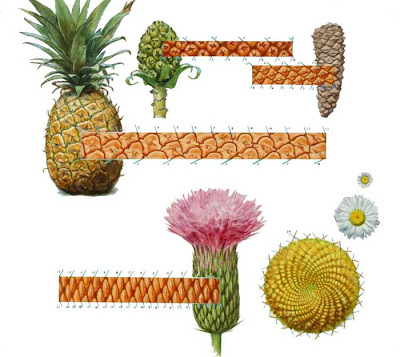
If you count the rows of seeds going one way around, you get 5, 8, or 13, etc. And if you count the rows going the other way around, you get another one of those numbers.
The video "Nature by Numbers" is a beautiful demonstration of the principles. Even if you’re not inclined toward numbers, there’s an unmistakable visual logic behind it.
A few inspired math teachers make the time in their curriculum to teach Fibonacci theory, along with fractals, topology, and tessellation, the right-brain branches of math that most teachers unfortunately have to skip over.
And maybe a math expert can explain in the comments why those Fibonacci numbers turn up in nature so universally.
From BoingBoing.
More at Lines and Colors.
Wikipedia on Fibonacci numbers.
View Next 14 Posts



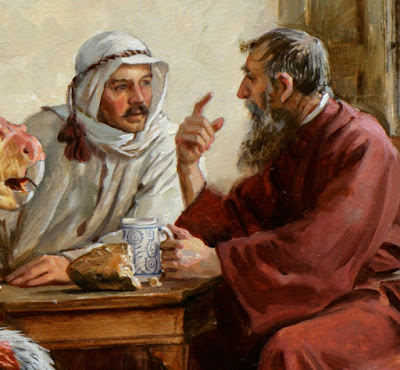
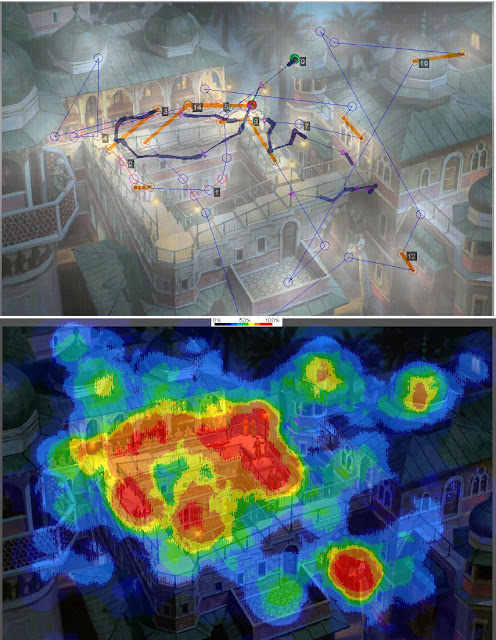
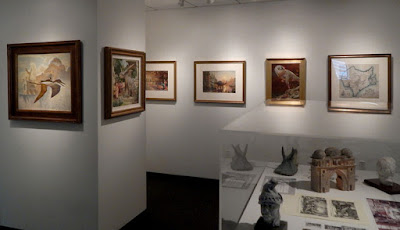
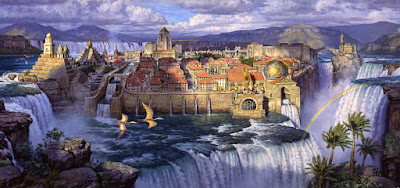
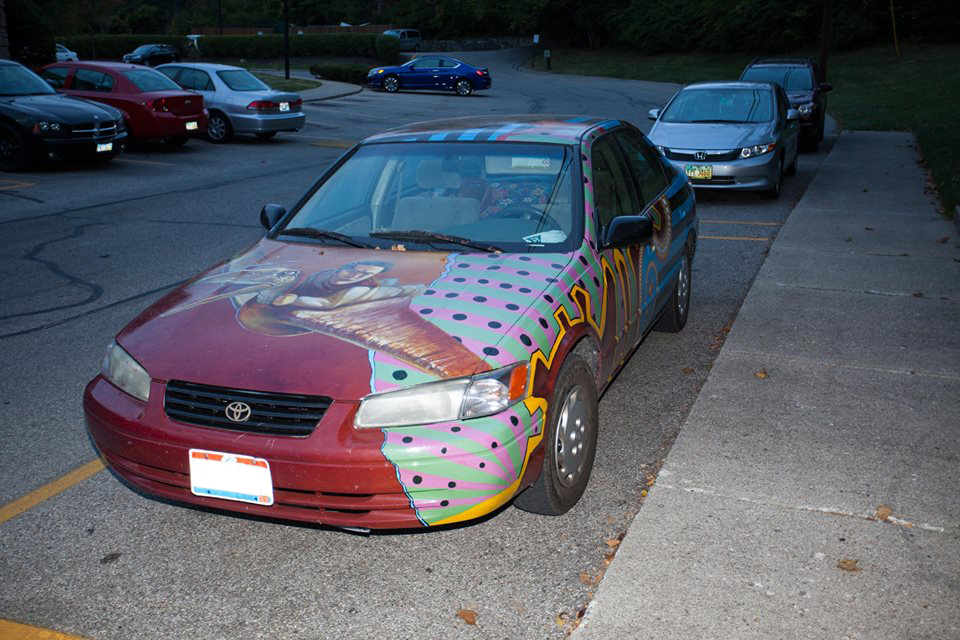


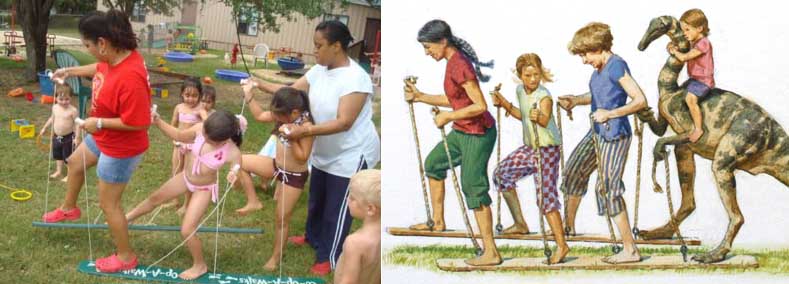
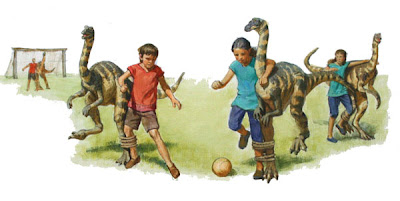
What a great way to study the progress of a painting!
Is there any way that the viewer can slow down the sequence, or is it pre-determined by the softwared?
I'd love to see more posts like this, if possible.
Thanks!!
It's predetermined, but I could control it and create another. Would people like to see it slower?
Don't bother on my behalf alone, James. Just wondering. But my pie-in-the-sky wish list (for what it's worth) would include someday for the viewer to be able to control the speed and to also see it in a larger and high-res version. What a great teaching that would be - not that it isn't great for what it is now.
Yes please! I'd like to see it slower, or as separate frames.
This is amazing! I would love to see you break down more of your paintings like this, it's always cool to see how an artist approaches their work.
@Tom - If you have Photoshop (Gimp or another software might work in the same way), save the picture as a .gif file and open it in that software. The separate frames should then load on individual layers, and you should be able to view it that way (:
James-
Thanks for sharing this. I love to see the different processes that artists use.
I'm wondering a couple of things:
1. I'm guessing you created tonal and color studies prior to the final painting. Did you create a fully rendered tonal drawing (a la Norman Rockwell) before moving on to the final piece?
2. Would you mind sharing approximately how long you spent creating the painting?
Thanks as always for all that you share with the art community!
I love it, and would also like to see another. Slower would be helpful, I think, to really get a good look at each stage. But what a great idea!
Tom and Catherine, I have reprogrammed and re-uploaded the animation to make it a lot slower. And
Ben, I have added above the preliminary pencil thumbnail where I worked out the basic tonal design. In this case I didn't do a full charcoal preliminary, just this quick (but very helpful) study. The painting took about a week, start to finish.
Thanks, Stuart for explaining. And Natascha, I'll try to do more of these in the future.
This comment has been removed by the author.
Hi James,
I have a technical question I hope you could help me with. Im about to start on a canvas. I've penciled in the line drawing, sprayed with final fixative, sealed with matte medium, and put an ultramarine imprimatura (oil). Its been 3days and I can still wipe some ultramarine off. It seems dry but not adhering? Never had this happen. Any idea whats going on?
If the action return (after), I think it will be much wave.
Ex. imagine 1, imagine 2, imagine 3, imagine 4, imagine 3, imagine 2 and reload algoritm. Like a wave; turn-return!
Sorry, just a suggestion.
Cale, I'm not sure what's going wrong there. What medium are you using? For the washin or imprimatura, you can just use Gamsol to thin the paint to a light wash and then build up the thicker and slower drying paint with the later applications. There shouldn't be any adhesion problems in any case.
Scorchfield, can you please explain what you're talking about?
In GIF the imagines are going one after other, but to the end the refreshing is too hard, because the dinamic is broke.
Why we not understand the moving of the wave with front and back of action?
After last imagine when all is full of colour, we put the imagine when all is empty (wrong, in my opinion).
I think, much better is put penultimate imagine, and so all. (Go and come :) )
example
http://scorchfield.blogspot.ro/2013/02/insula-carnivora.html
Just love the composition of this painting! Great to see the process gif
It's interesting to note some of the detail changes. I see that what appear to have originally been spoon shaped objects below the cello-like instrument on the far wall were replaced by a rack of recorders (?). Also, the pipe next to Dennison's elbow was replaced by a glass beaker.
Do you recall the reason for these changes? Art direction or your own decisions. Just curious...
I agree that slower would be helpful. It would be nice to be able to study each stage a little better rather than simply have a quick glance. Also, the slightly off position for registration might not be as noticeable.
Thank you for posting this! It is always a treat to see how master artists go about creating their work.
It gives a peek over your shoulder without distracting you from your beautiful work.
Tom, I'm glad you noticed the spoons changing into recorders. The nice thing about oil (or any opaque medium) is that such changes are possible. I did that because I wanted more musical instruments. I added the kerosene lamp instead of the clay pipe because I set up a still life and painted it from observation.
Diana, next time I do one of these, I'll make it just a bit slower.
Scorchfield, All the images are in order, and it starts over from the first step after the finish. I don't know how else to do it.
James,
oh yeah, just some OMS for medium and not much of it. Hmm I guess I will wait a while longer. If it continues any harm in trying to wipe it off with oms?
I remembered after I had put down the oil imprimatura that I could have just added a little ultramarine to the matte medium, doh!
Cale, you can do an imprimatura and color block-in with acrylic for a faster dry time. Oil over acrylic is always OK, but not vice-versa.
Thanks for sharing James, this is a real delight! Where did your color choices come into this process? Did you do any smaller color studies, or just attack it during the final painting? Thanks again, this blog is a tremendous resource for the art community.
Wow. This is a really neat way to view your process. Always intriguing! I find this particular approach very interesting. I do detailed pencils like that for my watercolors but rarely oils. Very cool. Thanks for sharing! P.S. Another way to make these GIFs is using Photoshop's "Animation window." (At the top, you can select "Windows" then "Animation" and manage the layers as frames.)
How did you keep the illustration board from warping?
John, it's heavyweight board, so it doesn't warp. But usually if you have a board that warps from a water medium on one side, just paint the back with water and it usually counteracts the effect.